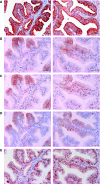The VEGF pathway and the AKT/mTOR/p70S6K1 signalling pathway in human epithelial ovarian cancer
- PMID: 19240722
- PMCID: PMC2661789
- DOI: 10.1038/sj.bjc.6604921
The VEGF pathway and the AKT/mTOR/p70S6K1 signalling pathway in human epithelial ovarian cancer
Abstract
Vascular endothelial growth factor (VEGF)-A inhibitors exhibit unseen high responses and toxicity in recurrent epithelial ovarian cancer suggesting an important role for the VEGF/VEGFR pathway. We studied the correlation of VEGF signalling and AKT/mTOR signalling. Using a tissue microarray of clinical samples (N=86), tumour cell immunohistochemical staining of AKT/mTOR downstream targets, pS6 and p4E-BP1, together with tumour cell staining of VEGF-A and pVEGFR2 were semi-quantified. A correlation was found between the marker for VEGFR2 activation (pVEGFR2) and a downstream target of AKT/mTOR signalling (pS6) (R=0.29; P=0.002). Additional gene expression analysis in an independent cDNA microarray dataset (N=24) showed a negative correlation (R=-0.73, P<0.0001) between the RPS6 and the VEGFR2 gene, which is consistent as the gene expression and phosphorylation of S6 is inversely regulated. An activated tumour cell VEGFR2/AKT/mTOR pathway was associated with increased incidence of ascites (chi(2), P=0.002) and reduced overall survival of cisplatin-taxane-based patients with serous histology (N=32, log-rank test, P=0.04). These data propose that VEGF-A signalling acts on tumour cells as a stimulator of the AKT/mTOR pathway. Although VEGF-A inhibitors are classified as anti-angiogenic drugs, these data suggest that the working mechanism has an important additional modality of targeting the tumour cells directly.
Figures







References
-
- Altomare DA, Wang HQ, Skele KL, De Rienzo A, Klein-Szanto AJ, Godwin AK, Testa JR (2004) AKT and mTOR phosphorylation is frequently detected in ovarian cancer and can be targeted to disrupt ovarian tumor cell growth. Oncogene 23(34): 5853–5857 - PubMed
-
- Badgwell BD, Camp ER, Feig B, Wolff RA, Eng C, Ellis LM, Cormier JN (2008) Management of bevacizumab-associated bowel perforation: a case series and review of the literature. Ann Oncol 19(3): 577–582 - PubMed
-
- Burger RA (2007) Experience with bevacizumab in the management of epithelial ovarian cancer. J Clin Oncol 25(20): 2902–2908 - PubMed
-
- Burger RA, Sill MW, Monk BJ, Greer BE, Sorosky JI (2007) Phase II trial of bevacizumab in persistent or recurrent epithelial ovarian cancer or primary peritoneal cancer: a Gynecologic Oncology Group Study. J Clin Oncol 25(33): 5165–5171 - PubMed
-
- Cannistra SA, Matulonis UA, Penson RT, Hambleton J, Dupont J, Mackey H, Douglas J, Burger RA, Armstrong D, Wenham R, McGuire W (2007) Phase II study of bevacizumab in patients with platinum-resistant ovarian cancer or peritoneal serous cancer. J Clin Oncol 25(33): 5180–5186 - PubMed
MeSH terms
Substances
LinkOut - more resources
Full Text Sources
Other Literature Sources
Medical
Molecular Biology Databases
Miscellaneous

